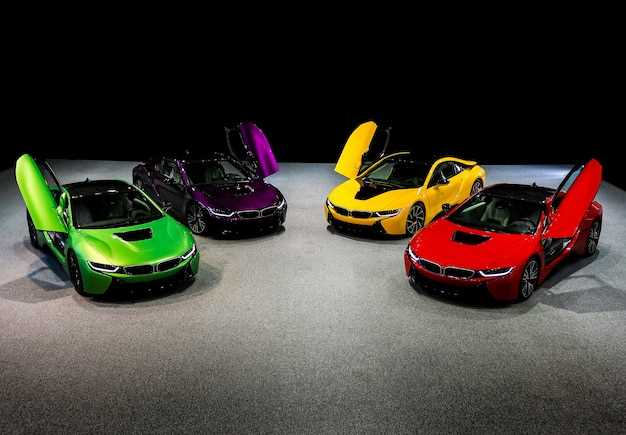
The evolution of sports cars is a fascinating journey that reflects not just advances in automotive technology, but also shifts in societal preferences and cultural trends. From the early models that prioritized speed and performance to the sleek and sophisticated machines of today, the transformation of these cars illustrates a dynamic interplay between engineering innovation and consumer demand.
In the 1950s and 1960s, sports cars were characterized by their raw power and simplicity. Iconic models such as the Jaguar E-Type and the Chevrolet Corvette emerged, captivating enthusiasts with their distinctive designs and exhilarating performance. These cars laid the groundwork for future innovations, setting standards that would shape the sports car segment for decades.
As we moved into the latter part of the 20th century, technological advancements began to emerge, leading to a new era of sports cars that featured improved aerodynamics, advanced materials, and enhanced safety features. The introduction of turbocharged engines and electronic systems allowed manufacturers to push the limits of speed and efficiency, resulting in cars that were not only faster but also more reliable.
Today, the landscape of sports cars continues to evolve, driven by the integration of electric and hybrid powertrains that promise not just power but also sustainability. As automotive manufacturers explore new frontiers in technology, the future of sports cars is set to be not only about performance but also about reducing environmental impact while still providing the exhilarating driving experience that enthusiasts crave.
Evolution of Design and Aerodynamics in Sports Cars from the 1960s to the 2020s
The evolution of design and aerodynamics in sports cars has significantly impacted performance and aesthetic appeal over the decades. In the 1960s, sports cars such as the Ferrari 250 GTO and the Porsche 911 featured classic, curvy designs that emphasized style alongside speed. These vehicles prioritized lightweight materials and simple aerodynamic forms to enhance handling and velocity.
As the 1970s arrived, the focus shifted towards integrating more advanced technology. The introduction of the Lamborghini Countach showcased sharp angles and aggressive lines, reflecting a desire for visual drama while still emphasizing aerodynamic efficiency. The use of fiberglass and innovative construction techniques began to influence sports car designs, enabling manufacturers to create lighter and more streamlined bodies.
The 1980s brought about a wave of innovations, including the rise of turbocharging and improved aerodynamics. Cars like the Porsche 959 featured active aerodynamics, where front and rear spoilers adjusted based on speed to optimize airflow. This decade also saw a move towards more standardized safety features, subtly shifting design priorities.
In the 1990s, manufacturers embraced digital technology, allowing for more precise aerodynamic modeling. The McLaren F1, known for its exceptional speed and handling, utilized wind tunnel testing to refine its shape. This era marked the beginning of extensive computational fluid dynamics (CFD) simulations in the design process, leading to revolutionary improvements in aerodynamics.
The turn of the millennium saw the introduction of hybrid technologies in sports cars, exemplified by the Porsche 918 Spyder. These vehicles combined traditional performance with sustainable engineering, seamlessly integrating hybrid systems into their designs without sacrificing aesthetics. Aerodynamics became even more critical, with designs focused on reducing drag and enhancing downforce.
By the 2020s, the evolution of sports car design reached new heights with the advent of electric vehicles. Models like the Tesla Roadster and Rimac Nevera featured sleek, futuristic silhouettes that capitalized on the absence of conventional internal combustion engines. The focus on aerodynamics in this era emphasizes reducing energy consumption and maximizing range while maintaining high performance.
Throughout the decades, the interaction between design and aerodynamics has continually shaped the identity of sports cars. Each era reflects a balance between form and function, underscoring the relentless pursuit of speed, efficiency, and stunning aesthetics in the world of sports cars.
Technological Advancements in Engine Performance and Fuel Efficiency Over the Years

The transformation of sports cars has been significantly influenced by advancements in engine technology, focusing on enhanced performance and improved fuel efficiency. Over the decades, manufacturers have adopted innovative engineering techniques to elevate the capabilities of sports cars.
In the early years, carbureted engines dominated, which were simple but inefficient. As technology progressed, the introduction of fuel injection systems revolutionized engine performance by providing more precise fuel delivery. This shift not only boosted power output but also contributed to better fuel economy, establishing a foundation for future developments.
The adoption of turbocharging in the 1980s marked a pivotal change in the sports car landscape. Turbochargers enhance engine performance by forcing more air into the combustion chamber, allowing for greater power without significantly increasing engine size. This advancement allowed manufacturers to produce lighter, more agile sports cars that maintained high levels of efficiency.
In the 1990s and 2000s, variable valve timing technology emerged, optimizing engine performance across different RPMs. This technology enabled sports cars to achieve a balance between power and fuel efficiency, adapting to various driving conditions. Alongside, advancements in lightweight materials, such as aluminum and carbon fiber, contributed to better performance through weight reduction.
The 2010s ushered in a new era of hybrids and electric sports cars, with brands like Porsche and Tesla leading the charge. Electric motors deliver instant torque, elevating performance levels beyond traditional combustion engines. Moreover, hybrid systems leverage both gasoline engines and electric power to enhance fuel efficiency while reducing emissions, appealing to a broader audience focused on sustainability.
Today, the trend towards downsizing engines continues, with manufacturers developing smaller, more efficient engines that produce impressive power outputs through complex engineering solutions like direct fuel injection and advanced turbocharging. These technological advancements not only redefine the performance benchmarks of sports cars but also contribute to a more eco-conscious automotive future.
Impact of Motorsport on Commercial Sports Car Development and Consumer Trends
The relationship between motorsport and commercial sports car development is profound and historically significant. Motorsport has served as a testing ground for innovations that filter down to consumer vehicles. Features such as advanced aerodynamics, lightweight materials, and high-performance engines have emerged from the rigorous demands of racing. Leading manufacturers invest heavily in motorsport to enhance their technological capabilities, which directly influences the evolution of their sports car offerings.
Throughout the decades, motorsport events such as Formula One and Le Mans have not only showcased cutting-edge engineering but also shaped consumer preferences. Performance metrics gleaned from racing experiences, such as speed, handling, and reliability, have become essential criteria for sports car buyers. As a result, brands often align their commercial models with the attributes of their racing counterparts, appealing to enthusiasts who desire a connection to the exhilarating sport.
Historical milestones in motorsport have also affected marketing strategies. For instance, the success of vehicles in prestigious competitions has enhanced brand prestige and consumer trust. Manufacturers like Ferrari and Porsche have leveraged their motorsport accolades to create a halo effect around their commercial sports cars, enticing consumers who seek performance and exclusivity.
Moreover, trends in consumer behavior have evolved in tandem with motorsport advancements. The rise of electric and hybrid technologies in racing has paralleled increasing consumer demand for environmentally friendly vehicles. This shift has prompted sports car makers to integrate sustainable technologies while maintaining high performance, reflecting a broader trend in the automotive industry influenced by the sport.
In summary, the impact of motorsport on the development of commercial sports cars is significant and multifaceted. The history of racing informs not only the engineering aspects of sports cars but also shapes consumer trends and expectations, illustrating a dynamic interplay between the two realms.



